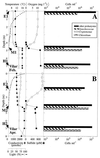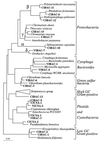Identification of and spatio-temporal differences between microbial assemblages from two neighboring sulfurous lakes: comparison by microscopy and denaturing gradient gel electrophoresis
- PMID: 10653710
- PMCID: PMC91855
- DOI: 10.1128/AEM.66.2.499-508.2000
Identification of and spatio-temporal differences between microbial assemblages from two neighboring sulfurous lakes: comparison by microscopy and denaturing gradient gel electrophoresis
Abstract
The microbial assemblages of Lake Cisó and Lake Vilar (Banyoles, northeast Spain) were analyzed in space and time by microscopy and by performing PCR-denaturing gradient gel electrophoresis (DGGE) and sequence analysis of 16S rRNA gene fragments. Samples obtained from different water depths and at two different times of the year (in the winter during holomixis and in the early spring during a phytoplankton bloom) were analyzed. Although the lakes have the same climatic conditions and the same water source, the limnological parameters were different, as were most of the morphologically distinguishable photosynthetic bacteria enumerated by microscopy. The phylogenetic affiliations of the predominant DGGE bands were inferred by performing a comparative 16S rRNA sequence analysis. Sequences obtained from Lake Cisó samples were related to gram-positive bacteria and to members of the division Proteobacteria. Sequences obtained from Lake Vilar samples were related to members of the Cytophaga-Flavobacterium-Bacteroides phylum and to cyanobacteria. Thus, we found that like the previously reported differences between morphologically distinct inhabitants of the two lakes, there were also differences among the community members whose morphologies did not differ conspicuously. The changes in the species composition from winter to spring were also marked. The two lakes both contained sequences belonging to phototrophic green sulfur bacteria, which is consistent with microscopic observations, but these sequences were different from the sequences of cultured strains previously isolated from the lakes. Euryarchaeal sequences (i.e., methanogen- and thermoplasma-related sequences) also were present in both lakes. These euryarchaeal group sequences dominated the archaeal sequences in Lake Cisó but not in Lake Vilar. In Lake Vilar, a new planktonic population related to the crenarchaeota produced the dominant archaeal band. The phylogenetic analysis indicated that new bacterial and archaeal lineages were present and that the microbial diversity of these assemblages was greater than previously known. We evaluated the correspondence between the abundances of several morphotypes and DGGE bands by comparing microscopy and sequencing results. Our data provide evidence that the sequences obtained from the DGGE fingerprints correspond to the microorganisms that are actually present at higher concentrations in the natural system.
Figures





References
-
- Altschul S F, Gish W, Miller W, Myers E W, Lipman D J. Basic local alignment search tool. J Mol Biol. 1990;215:403–410. - PubMed
-
- Aravalli R N, She Q X, Garrett R A. Archaea and the new age of microorganisms. Trends Ecol Evol. 1998;13:190–194. - PubMed
-
- Brock T D. The study of microorganisms in situ: progress and problems. Symp Soc Gen Microbiol. 1987;41:1–17.
Publication types
MeSH terms
Substances
Associated data
- Actions
- Actions
- Actions
- Actions
LinkOut - more resources
Full Text Sources
Molecular Biology Databases

